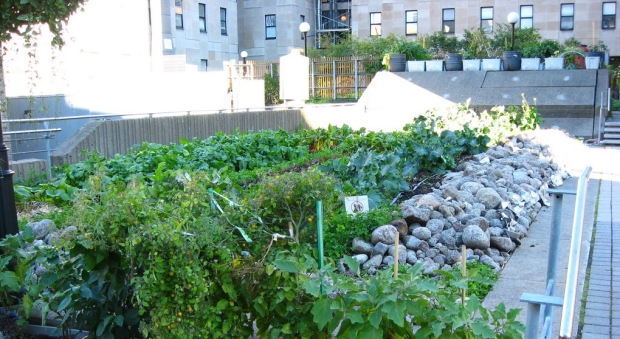South Dakota already had a farming population prior to the War, but some things have changed dramatically. Farming for many years after the war was a subsistence venture, with people growing in-house, rooftop, or communal gardens to try to survive. Old office complexes, stores, and other facilities became indoor communal gardening areas, and continue to serve this function. Some plants could not be grown either because the original was hybridized or because the plant could not survive the harsher conditions after the War. Colder winters and summers and less sunlight because of the massive dust clouds in the air caused mass food shortages and the Dalton population plummeted.
Farmers are limited to the amount of land they can plow plant and harvest with horse teams and cobbled together equipment, so many farms are small and close to the city border. Farms that are farther from the town are more at risk of animal damage and also raids by renegades. This was more common in early postwar years, before the society organized itself, but there is still the occasional raid and murder of a farmer. This is another reason the rail riders are a concern.
As weather patterns stabilized and growers who had usable seed shared it with other survivors, gardening began to thrive again.

Communal garden in the Green Sector
Roof gardens are popular in the Blue and in Red and Green, while White and Gold usually have enough land space to have a ground garden. Some farmers grow large quantities of vegetables to sell, but for the most part individual families provide their own vegetables. Beets, beans, various kinds of squashes, cucumbers, carrots, potatoes, tomatoes, onions, broccoli and peppers are all grown. Dandelions and shamrock plants are cultivated for their leaves to use as salads. Sunflowers are also grown and their seeds are often pressed for an oil that makes a usable alternative to meat fats, especially for vegetarian Mixeds. Garden foods are often preserved by drying or canning, with beeswax used to seal the tops of canning jars.
Wheat, oats, corn, and barley are all grown on farms outside the city. These are mainly used as animal feed or grains for flour, but some are also made into homemade beers. Grains are processed in the Grey into flour, farmers grind only enough on their own for their own use. Beers are usually made on the farms and then sold in the city. Straw from the harvest is used for animal bedding and making mattresses. Hay and alfalfa are grown for animal feed as well, and baled and transported to the city to sell because of the many horse owners. because of the demand, there is a large farm population outside Dalton, who are now protected by the Perimeter Guard.
Herbs are grown indoors or outside in small herb gardens and are used to flavor food and create medicines. Lavender, mint, sage, bearberry, bee balm, chamomile, feverfew, garlic, burdock, chickory, thyme, chives, and spice peppers are all commonly used herbs. Herbal cures and medicines were learned from the Native American reservation residents who moved into the Dalton area after the War. They brought with them farming and survival knowledge as well, and fewer died during the disease and starvation of the early winters. They and their descendants make up nearly forty percent of the human Dalton population. They continue to act as doctors, and often are the most reliable dealers in medical tonics and cures.
Cranberries, elderberries, blackberries, wild raspberries, mulberries, and wild apples and plums can be harvested outside the city walls, and are used to make jams and jellies, cider, cider vinegars, and wines. Some gardeners with enough space plant the plum or apple seeds in their gardens. Many roof gardeners who do not want runners spoiling their crop plant berry briars along the exterior edges of their walls.
Hazelnut, walnut, sugar maple, oak and birch trees are all found in the forests as well. Maples are tapped for sugars, hazelnut, walnut, and oak trees all produce edible nuts, and walnut and oak wood can be used in construction. Oaks also provide tannin-rich leaves for leather curing, and the nuts can be ground into a flour. Walnut juices are used to dye fabrics and hair. Birch oil and bark are used for starting fires.
Farmers also raise beef and milk cattle, pigs, goats, chickens, ducks, geese, sheep and rabbits. Cattle are often used for dairy until they no longer adequately produce, and are then sold for meat and leather production. Goats tend to have the same function although their hair can be made into yarns as well. Milk is either used directly or made into cheese or butter. Sheep are kept mainly for fleece production. Pigs supply meat and also act as garbage disposal systems for the town. Ducks, geese and chickens supply eggs, meat and down feathers for making quilts, pillows and mattresses. Rabbits are kept for meat and some have been selectively bred to be longer haired and used for yarn making. Some households in the White and Gold have their own milk cow or goats, and many have chickens, ducks, or rabbits. Even roof gardeners in the Blue who are carnivore Mixeds generally keep small animals instead of a large garden. They tend to raise rabbits, rats and mice, and pigeons. Meats are eaten fresh, dried, or salted for preservation.
Horses are kept for transportation and farm work. Many are descendants of horses that were captured running wild after escaping farms during the War, and are of indeterminate breeding. A large draft-style breed and a lighter riding breed have been selectively created, but there are still anomalies because of the genetic intermixing. A third type, a small, stocky, hardy animal like a large pony, is the most common wild horse and is also a cheap cart animal when captured.
Fish disappeared from Rapid Creek in the city for a time because of the pollution from the Blue, but since efforts to clean the water it is again possible to catch trout and other fish from the river both inside and outside the city. Pike, perch and bass can be found in ponds and lakes in the area as well. Fish are not farmed in any way, but fishing is a popular way for the homeless living along the river edges and residents of the Blue to get meat that is fresh and trustworthy.
Bees are kept both on farms and in the town, since they are good garden pollinators. Honey is used as a sweetener and in many herbal medicines, as well as a wound antibacterial application. The beeswax is used to waterproof boots, polish furniture, make candles, and seal canning jars.
The city is supplied with salt from mines north of the town, where some human prisoners and remanded Mixeds are sent to work. Sugar is supplied from either sugar beets, maple sap, or honey, and breads are usually either sourdoughs or made flat, although many professional bakeries make and dry their own yeasts. The various methods they use often gives each bakery’s bread a very distinctive flavor and many people can identify which place their food is from simply by taste.


2 thoughts on “Food and Farming”